List of non-marine molluscs of Turkey
The non-marine molluscs of the country of Turkey are a part of the molluscan fauna of Turkey. The biodiversity of non-marine molluscs of Turkey is richer than in surrounding European states.[1]
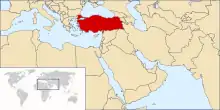
There are at least 825 species of non-marine molluscs living in the wild in Turkey. An approximate guess to the total number, however, is of about 1030 non-marine molluscs in Turkey (see the table below). There are a total of 825 species of gastropods, which breaks down to 95 (counted 80[2] "Prosobranchia" only and at least 15 other freshwater snails from this list) taxa of freshwater gastropods (including brackish water species),[2] and 730 species (and subspecies)[3] of land gastropods. There is also relevant number of freshwater bivalves living in the wild in Turkey.
According to Gümüş et al. (2009),[3] the Turkish malacofauna of land gastropods currently comprises 730 valid species and subspecies of terrestrial snails, belonging to 36 families.
Gümüş et al. (2009)[3] stated that Turkey has a very rich freshwater malacofauna with a very large proportion of endemic species.[3] Those authors estimated that Turkey is inhabited by at least 300 species of freshwater molluscs.[3]
| Mollusc | Number |
|---|---|
| Freshwater gastropods | at least 95 taxa (80 species and subspecies of "Prosobranchia" include brackish waters[2] + 15 other freshwater snails from this list) |
| Land gastropods | 730 valid species and subspecies[3] and estimation is over 1.000 including species and subspecies waiting to be recovered[3] |
| Total gastropods | 825 |
| Bivalves | ?? |
| non-marine molluscs | at least 825 gastropods plus unknown number of freshwater bivalves. (730[3] taxa of land gastropods + approximate guess 300[3] freshwater molluscs = gives approximate guess of about 1030 taxa of non-marine molluscs.) |
There are also significant numbers of non-indigenous species, including bivalves and various synanthropic gastropods and bivalves.
Land gastropods overview

A country such as Turkey, with a highly variable relief and a diversified climate and vegetation, can support a similarly rich and diversified malacofauna of terrestrial gastropods. Consequently, the recent changes in both land use and climate (which is gradually shifting from semi-arid and winter-cold Central Turkey to a subtropical periphery with high humidity during winter) have immediately affected the malacofauna, causing area shifts following the unstable environmental conditions, including depletion or even complete loss of some populations. Increasing pasture farming leads to a loss of forest vegetation, and thus to a loss of those molluscan species which are adapted to such conditions.[3]
The recent rise of average summer temperature resulting from global warming may particularly affect the Mediterranean species.[3] Gümüş et al. (2009)[3] speculated that both the average length of the dry summer period and the absolute temperature are rising, and that the aestivation period of species adapted to the Mediterranean drought is now too long. The animals die from starvation or desiccation, and several species or subspecies may already be approaching the verge of extinction.[3]
As far as nomenclature, an average of two to three additional synonym names for each taxon are available to land gastropods in Turkey.[3]
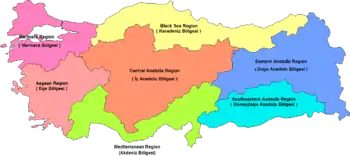
The degree of endemism for the area of Turkey is about 65%.[3] The degree of endemism on the species level is relatively high and is comparable to that of Greece, which houses the highest number of terrestrial snail taxa in Europe, with a similarly high value of endemism.[3] In Turkey, several pulmonate families reach a maximum of biodiversity. The biodiversity has been able to develop there without any major interruptions since the Pliocene.[3]
The malacofauna of some areas, such as the inner Anatolian steppe areas, and many of the densely forested mountain ranges, is incompletely ascertained or almost completely unknown.[3] As research progresses, records of species new to science can be expected, and the knowledge of the ranges of already-known taxa will increase. Another accretion in taxa numbers may be caused by the resolution of cryptic species clusters with the help of DNA sequencing methods, the Barcoding Project, and other related activities.[3]
History of malacozoology of terrestrial gastropods
The first species from the Turkish terrestrial malacofauna were described by Guillaume-Antoine Olivier (1756–1814), who, amongst others, collected natural history objects in the Middle East. For example he named the following species: Multidentula ovularis (Olivier, 1801) and Bulgarica denticulata (Olivier, 1801) from "Ghemlek" (= Gemlik in the Bay of Mudanya) or Assyriella guttata (Olivier, 1804) from Urfa.[5] After Olivier, the area was visited by the German Johannes Rudolf Roth and his party,[6] and then was target of other scientists, naturalists and collectors like Bellardi, Boissier, Dubois de Montpereux, Frivaldsky, Huet de Pavillon, Parreyss, Schläfli, Sievers and others. Their collections went to the most prolific malacologists interested in the area like Jules René Bourguignat, Jean de Charpentier, Heinrich Carl Küster, Johann Rudolf Albert Mousson, Ludwig Karl Georg Pfeiffer and Emil Adolf Rossmässler. In the second half of the 19th century, the famous German malacologists Oskar Boettger and Wilhelm Kobelt from the Senckenberg Museum in Frankfurt intensified the malacological research in Turkey, with contributions by Gottfried Nägele, Otto von Retowski and Carl Agardh Westerlund. After Kobelt’s death in 1916, the "Golden Age" of malacology was finished except for some contributions by Paul Hesse, Wassili Adolfovitch Lindholm and Otto W. von Rosen. After almost 50 years of scientific silence, it was the "Netherlands biological expedition to Turkey 1959", which again shifted the focus of malacologists to Turkey.[7] Since then, the malacological science received an enormous boost and stimulated both international as well as Turkish scientists to deepen the knowledge of the Turkish malacofauna. During this period, which now lasts about 50 years, one third of the number of taxa accepted today as valid has been added! Some of the most active contributors to this success should be mentioned here (in alphabetic order of the surnames): R. A. Bank; G. Falkner; L. Forcart; E. Gittenberger; Z. P. Erőss; Z. Fehér; B. A. Gümüş; B. Hausdorf; V. Hudec; H.P.M.G. Menkhorst; L. Németh; E. Neubert; H. Nordsieck; B. Páll-Gergely; W. Rähle; A. Riedel; H. Schütt; R. Şeşen; M.I. Szekeres; A. Wiktor and M. Z. Yıldırım.[3]
Freshwater gastropods
- Theodoxus fluviatilis (Linnaeus, 1758)[2][8] - Theodoxus fluviatilis fluviatilis (Linnaeus, 1789), Theodoxus fluviatilis euxinus (Clessin, 1885)[2]
- Theodoxus heldreichi (Martens, 1879) - Theodoxus heldreichi heldreichi (Martens, 1879), Theodoxus heldreichi fluvicola Schütt & Seşen, 1992[2]
- Theodoxus anatolicus (Recluz, 1841)[2]
- Theodoxus syriacus (Bourguignat, 1852)[2]
- Theodoxus altenai Schütt, 1965[2]
- Theodoxus jordani (Sowerby, 1832)[1][2]
- Theodoxus cinctellus (Martens, 1874)[2]
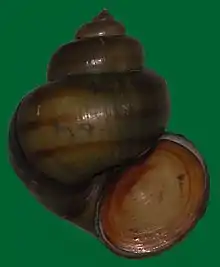
- Viviparus mamillatus (Küster, 1852)[2]
- Viviparus contectus (Millet, 1813)[2]
- Viviparus viviparus costae (Mousson, 1863)[2]
- Melanoides tuberculata (O. F. Müller, 1774)[1][2]
- Melanopsis praemorsa (Linnaeus, 1789) - Melanopsis praemorsa praemorsa (Linnaeus, 1789), Melanopsis praemorsa ferussaci Roth, 1839,[1] Melanopsis praemorsa maximalis Schütt, 1974[2]
- Melanopsis buccinoidea (Olivier, 1801)[2]
- Melanopsis costata (Olivier, 1804) - Melanopsis costata costata (Olivier, 1804),[1] Melanopsis costata chantrei Locard, 1921[2]
- Melanopsis nodosa Férussac, 1823[2]
- Esperiana esperi (A. Férussac, 1823)[2]
- Esperiana sangarica Schütt, 1974[2]
- Esperiana acicularis stussineri Schütt, 1974[2]
- Bithynia tentaculata (Linnaeus, 1758)[2]
- Bithynia leachii (Sheppard, 1823)[2]
- Bithynia pseudemmericia Schütt, 1964[2]
- Bithynia phialensis (Conrad, 1852)[1][2]
- Bithynia badiella (Küster, 1852)[2]
- Bithynia pentheri Sturany, 1905[2]
- Bithynia pesici - Note: listed by Şereflişan (2009),[1] but not listed by Yildirim (2006)[2]

- Potamopyrgus antipodarum J. E. Gray, 1843 - non-indigenous[2][8]
- Hydrobia ventrosa (Montagu, 1803)[2]
- Hydrobia stagnorum (Gmelin, 1790)[2]
- Peringia ulvae (Pennant, 1777)[2]
- Hydrobia soosi (Wagner, 1928)[2]
- Hydrobia anatolica Schütt, 1965[2]
- Pseudamnicola geldiayana Schütt, 1970[2]
- Pseudamnicola intranodosa Schütt, 1993[2]
- Pseudamnicola bilgini Schütt, 1993[2]
- Pyrgorientalia zilchi (Schütt, 1964)[2]
- Kirelia carinata Radoman, 1973[2]
- Kirelia murtici Radoman, 1973[2]
- Falsipyrgula pfeiferi (Weber, 1927)[2]
- Falsipyrgula beysehirana (Schütt, 1965)[2]
- Falsipyrgula schuetti Yildirim, 1999[2]
- Horatia parvula (Naegele, 1894)[2]
- Pseudorientalia natolica (Küster, 1852) - Pseudorientalia natolica natolica (Küster, 1852), Pseudorientalia natolica smyrnensis Schütt, 1970[2]
- Falsibelgrandiella bunarica Radoman, 1973[2]
- Tefennia tefennica Schütt & Yildirim, 2003[2] - Tefenni spring snail
- Orientalina caputlacus Schütt, 1993[2]
- Turkorientalia anatolica Radoman, 1973[2]
- Sheitanok amidicus Schütt & Şeşen, 1991[2]
- Graecoanatolica lacustristurca Radoman, 1973[2]
- Graecoanatolica tenuis Radoman, 1973[2]
- Graecoanatolica kocapinarica Radoman, 1973[2]
- Graecoanatolica conica Radoman, 1973[2]
- Graecoanatolica brevis Radoman, 1973[2]
- Graecoanatolica pamphylica (Schütt, 1964)[2]
- Heleobia longiscata (Bourguignat, 1856)[2]
- Belgrandiella edessana Schütt, 1993[2]
- Belgrandiella cavernica Boettger, 1957[2]
- Belgrandiella adsharica (Lindholm, 1913)[2]
- Sadleriana affinis (Frauenfeld, 1863)[2]
- Sadleriana byzanthina (Küster, 1852) - Sadleriana byzanthina byzanthina (Küster, 1852), Sadleriana byzanthina demirsoyii Yildirim & Morkoyunlu, 1997[2]
- Sadleriana fluminensis (Küster, 1852)[2]
- Sadleriana minuta (Naegele, 1903)[2]
- Islamia pseudorientalica Radoman, 1973[2]
- Islamia anatolica Radoman, 1973[2]
- Islamia bunarbasa (Schütt, 1964)[2]
- Lithoglyphus naticoides (C. Pfeiffer, 1828)[2]
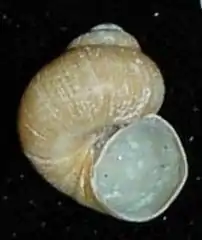
- Bythinella turca Radoman, 1976[2]
- Bythinella occasiuncula Boeters & Falkner, 2001[2][9]
- Bythinella sp. A - an unidentified species from Istambul sensu Yildirim (2006)[2]
- Paludinella littorina (delle Chiaje, 1828)[2]
- Valvata cristata O. F. Müller, 1774[2]
- Valvata saulcyi Bourguignat, 1853[1][2]
- Valvata macrostoma (Mörch, 1864)[2]
- Valvata piscinalis (O. F. Müller, 1774)[1][2]
- Borysthenia naticina (Menke, 1845)[2]
(All species above this line are freshwater "Prosobranchia".)
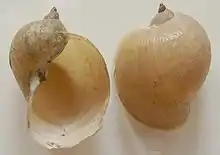
- Heleobia contempta (Dautzenberg, 1894) / Semisalsa contempta (Dautzenberg, 1894)[1]
- Heleobia longiscata (Bourguignat, 1856) / Semisalsa longiscata (Bourguignat, 1856)[1]
- Anisus leucostoma (Millet, 1813)[1]
- Anisus spirorbis (Linnaeus, 1758)[1]
- Anisus vortex (Linnaeus, 1758)[1]
- Anisus vorticulus (Troschel, 1834)[1]
- Gyraulus albus (O. F. Müller, 1774)[1]
- Gyraulus euphraticus (Mousson, 1874)[1]
- Gyraulus laevis (Alder, 1838)[1]
- Gyraulus pamphylicus Glöer & Rähle, 2007[10]
- Gyraulus parvus (Say, 1817)[1]
- Gyraulus piscinarum (Bourguignat, 1852)[1]
- Radix auricularia (Linnaeus, 1758)[1]
- Radix peregra (O. F. Müller, 1774) - synonym: Radix labiata (Rossmässler, 1835)[1]
- Myosotella myosotis (Draparmaud, 1801) - semi-marine[8]
Land gastropods
Species of gastropods of Turkey include:
- Leucophytia bidentata (Montagu, 1808) - semi-marine species
- Pyramidula cephalonica (Westerlund, 1898)[11]
- Pyramidula chorismenostoma (Westerlund & Blanc, 1879)[12]
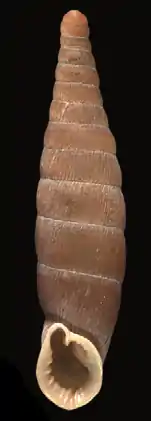
- 175 species of Clausiliidae in Turkey.[3] Turkey is home to 95% of the subfamily Mentissoideinae.[3]
- Pontophaedusa funiculum (Mousson, 1856)[13]
- Bulgarica denticulata (Olivier, 1801)
- Papillifera bidens (Linnaeus, 1758) - synonym: Papillifera papillaris (O. F. Müller, 1774)[14]
- Sprattia sowerbyana O. Boettger, 1883[15]
- Albinaria latelamellaris Neubert, Örstan & Welter-Schultes, 2000[16]
- Pupilla triplicata (Studer, 1820)[17]
- 41 species of Orculidae in Turkey[3]
- Alvariella
- Alvariella multiplicata Hausdorf 1996
- Orcula
- Orcula zilchi Urbański, 1960[18]
- Orculella
- Orculella bulgarica bulgarica (P. Hesse 1915)[19]
- Orculella bulgarica lamellata Hausdorf, 1996[19]
- Orculella critica Hausdorf, 1996[19]
- Orculella garzanensis Schütt, 1996
- Orculella? heterostropha commagenensis (Neubert, 1988)[19]
- Orculella? heterostropha heterostropha (O. Boettger, 1905)[19]
- Orculella ignorata Hausdorf, 1996[19]
- Orculella menkhorsti menkhorsti Hausdorf, 1996[19]
- Orculella menkhorsti sinistrorsa Hausdorf, 1996[19]
- Orculella mesopotamica mesopotamica (Mousson, 1874)[19]
- Orculella mesopotamica riedeli Hausdorf, 1996[19]
- Orculella orientalis (L. Pfeiffer 1861)[19]
- Orculella? palatalis (Pilsbry 1922)[19]
- Orculella pfeiferi Hausdorf 1996[19]
- Orculella ruderalis urartaeica Hausdorf 1996[19]
- Orculella sirianocoriensis libanotica (Tristram 1865)[19]
- Pilorcula Germain, 1912
- Pilorcula trifilaris anatolica Hausdorf, 1996
- Pilorcula trifilaris longior Hausdorf, 1996
- Schileykula
- Schileykula aculeata E. Gittenberger & Menkhorst, 1993[20]
- Schileykula attilae Páll-Gergely, 2010[18]
- Schileykula batumensis (Retowski, 1889)
- Schileykula inversa Schütt, 1993
- Schileykula nordsiecki Hausdorf, 1996
- Schileykula (?) robusta (Nägele, 1910)
- Schileykula scyphus cilicica Hausdorf, 1996
- Schileykula scyphus enteroplax (Pilsbry, 1922)
- Schileykula scyphus erecta Hausdorf, 1996
- Schileykula scyphus lycaonica Hausdorf, 1996
- Schileykula scyphus scyphus (L. Pfeiffer, 1848)
- Schileykula sigma Hausdorf, 1996
- Schileykula trapezensis acampsis Hausdorf, 1996
- Schileykula trapezensis contraria Neubert, 1993
- Schileykula trapezensis neuberti Hausdorf, 1996
- Schileykula trapezensis trapezensis (Stojaspal, 1981)
- Sphyradium
- Sphyradium doliolum (Bruguière, 1792)
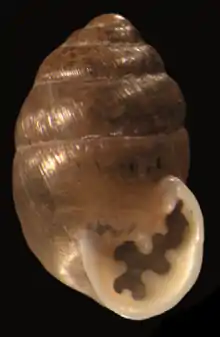
- Enormous radiation of the family Enidae on the Macaronesian Islands: 115 species of Enidae in Turkey[3]
- Multidentula ovularis (Olivier, 1801)
genus Ena: 3 species in Turkey[21]
- Ena nogellii (Roth, 1850) - synonym: Buliminus ponticus Retowski, 1886[21]
- Ena menkhorsti Hausdorf & Bank, 2001[21]
- Ena dazimonensis Hausdorf & Bank, 2001[21]
- Chondrula lycaonica (Sturany, 1904)
- Chondrula orientalis (Pfeiffer, 1848)
- Chondrula sturmii (Küster, 1852)
- Chondrula werneri (Sturany, 1902)
- Imparietula ridvani Schütt, 1995[18]
- 45 species of Oxychilidae in Turkey[3]
- Nastia viridula Riedel, 1989 - north-eastern Turkey[22]
- Zonites algirus (Linnaeus, 1758)[23]
- Drilolestes retowskii (O. Boettger, 1884)[24]
- Selenochlamys pallida O. Boettger, 1883[25]
- Trigonochlamys imitatrix O. Boettger, 1881[26]
- Tandonia budapestensis (Hazay, 1880)[27]
- Deroceras turcicum (Simroth, 1894)
- Lindholmiola lens (Férussac, 1832)[28]
- Turkey has 112 species of Hygromiidae[3] and it is strong for several endemic genera of Hygromiidae.[3]
- Harmozica occidentalis Hausdorf, 2004[29]
- Monacha oecali Hausdorf & Páll-Gergely, 2009[30]
- Monacha georgievi Páll-Gergely, 2010[18]

- Turkey has 52 species of the subfamily Helicinae.[3]
- Assyriella guttata (Olivier, 1804)
Bivalves
See also
Lists of molluscs of surrounding countries:
- List of non-marine molluscs of Bulgaria
- List of non-marine molluscs of Greece
- List of non-marine molluscs of Georgia (country)
- List of non-marine molluscs of Armenia
- List of non-marine molluscs of Azerbaijan
- List of non-marine molluscs of Iran
- List of non-marine molluscs of Iraq
- List of non-marine molluscs of Syria
- List of non-marine molluscs of Cyprus
References
This articles incorporates CC-BY-3.0 text from reference.[3]
- Şereflişan H., Yildirim M. Z. & Şereflişan M. (2009). "The gastropod fauna and their abundance, and some physicochemical parameters of Lake Gölbaşı (Hatay, Turkey)". Turkish Journal of Zoology 33(3): 287-296. abstract Archived 22 August 2011 at the Wayback Machine, PDF Archived 28 September 2011 at the Wayback Machine
- Yildirim M. Z., Koca S. B. & Kebapçi U. (2006). "Supplement to the Prosobranchia (Mollusca: Gastropoda) Fauna of Fresh and Brackish Waters of Turkey". Turkish Journal of Zoology 30: 197-204. PDF
- Gümüş B. C. & Neubert E. (2009). "The biodiversity of the terrestrial malacofauna of Turkey – status and perspectives". In: Neubert E., Amr Z., Taiti S., Gümüş B (Eds.) Animal Biodiversity in the Middle East. Proceedings of the First Middle Eastern Biodiversity Congress, Aqaba, Jordan, 20–23 October 2008. ZooKeys 31: 105-117. doi:10.3897/zookeys.31.169.
- Cook L. M. (1997). "Geographic and ecological patterns in Turkish land snails". Journal of Biogeography 24(4): 409–418. doi:10.1111/j.1365-2699.1997.00139.x, JSTOR.
- (in French) Olivier G. A. (1801–1807). Voyage dans l’Empire Othoman, l’Egypte et la Perse, fait par ordre du Gouvernement, pendant les six premières années de la République. Tome premier: 432 pp. (1801); Atlas, 1st. livraison: VII pp., pl. 1–17 (1801); Tome second: 466 pp. (1804); Atlas, 2d livraison: VII pp., pl. 18–32 (1804); Tome troisième: 566 pp. (1807); Atlas, 3d livraison: VIII pp., pl. 34–50 (1807). Paris (Agasse).
- (in Latin) Roth J. R. (1839). Molluscorum species, quas in itinere per Orientem facto comites clariss. Schubert doctores M. Erdl et J.R. Roth collegerunt. Dissertatio inauguralis. München (Wolf): 26 pp., pl. 1–2.
- Anonymus (1963). "Concise survey of localities and collection numbers of zoological and botanical specimens, collected by the Netherlands biological expedition to Turkey 1959". Zoologische Mededelingen 38(8): 129–151, Leiden.
- Demir M. (2003). "Shells of Mollusca Collected from the Seas of Turkey". Turkish Journal of Zoology 27: 101-140. PDF Archived 3 March 2016 at the Wayback Machine
- (in German) Boeters H. D. & Falkner G. (2001). "Bythinella occasiuncula n. sp., ein neuer Kleinprosobranchier aus der Türkei (Gastropoda: Hydrobiidae)". Heldia 3(2/3): 51-52.
- Glöer P. & Rähle W. (2007). "Gyraulus pamphylicus n. sp. – a new species from Turkey (Mollusca: Gastropoda: Planorbidae)". Mollusca 27(1): 57-60. PDF
- Gittenberger E. & Bank R. A. (1996). "A new start in Pyramidula (Gastropoda Pulmonata: Pyramidulidae)". Basteria 60: 71-78.
- Pyramidula chorismenostoma. AnimalBase. Accessed 14 December 2008.
- Páll-Gergely B. & Németh L. (2008). "Observations on the breeding habits, shell development, decollation, and reproductive anatomy of Pontophaedusa funiculum (Mousson 1856) (Gastropoda, Pulmonata, Clausiliidae, Phaedusinae)". Malacologica Bohemoslovaca 7: 11-14. Online serial at <http://mollusca.sav.sk> 8-February-2008.
- Gümüş B. A. (2006) "Additional data to the distribution of Papillifera papillaris (O. F. Müller, 1774) (Gastropoda: Pulmonata: Stylommatophora: Clausiliidae) in Istanbul, Turkey". The Archaeo+Malacology Group Newsletter 10: 4–6. http://triton.anu.edu.au/issue_10.htm
- Yıldırım M. Z. (1997). "A new subspecies of Sprattia sowerbyana O. Boettger, 1883 from Eğirdir (Turkey): Sprattia sowerbyana aksoylari nov. subsp. (Mollusca, Pulmonata, Clausiliidae)". Turkish Journal of Zoology 21: 219–221, Ankara.
- Neubert E., Örstan A. & Welter-Schultes F. (2000) "The land snails between Kaş and Demre, southwestern Turkey, with special reference to Albinaria (Gastropoda, Pulmonata, Clausiliidae)". Basteria 64: 105-123.
- "Species summary for Pupilla triplicata". AnimalBase. Last modified 15-04-2010, accessed 31 July 2010.
- Páll-Gergely B. (2010). "New and little known land snails from Turkey (Gastropoda: Pulmonata)". Zoology in the Middle East 50: 89-94. Heidelberg. abstract.
- Hausdorf, B. (1996). "Die Orculidae Asiens (Gastropoda: Stylommatophora)"]. Archiv für Molluskenkunde 125 (1/2): 1-86.
- Gittenberger, E.; Menkhorst, H.P.M.G. (1993). "Schileykula aculeata spec, nov., a conspicuous species from Turkey with spiny ribs on its shell (Mollusca: Gastropoda Pulmonata: Orculidae". Zoologische Mededelingen. 67: 341–343.
- Hausdorf B. (2001). "The genus Ena in Turkey, with remarks on its phylogenetic relationships (Gastropoda: Buliminidae)". Journal of Natural History 35(11): 1627–1638, London. PDF Archived 1 November 2006 at the Wayback Machine
- "Species summary for Nastia viridula". AnimalBase, last modified 28 February 2006, accessed 3 September 2010.
- Örstan A. (2003). "The rediscovery of Zonites algirus in İstanbul, Turkey (Gastropoda: Pulmonata: Zonitidae)". Zoology in the Middle East 29: 75-78. Summary at http://home.earthlink.net/~aydinslibrary/Zalgirus.htm
- "Species summary for Drilolestes retowskii". AnimalBase, last modified 14 June 2007, accessed 7 September 2010.
- "Species summary for Selenochlamys pallida". AnimalBase, last modified 14 June 2007, accessed 7 September 2010.
- "Species summary for Trigonochlamys imitatrix". AnimalBase, last modified 14 June 2007, accessed 7 September 2010.
- "Species summary for Tandonia budapestensis". AnimalBase, last modified 14 February 2009, accessed 26 August 2010.
- "Species summary for Lindholmiola lens". AnimalBase, accessed 18 June 2009.
- Hausdorf B. (July 2004). "Harmozica occidentalis new species from the eastern Pontus Mountains in Turkey (Gastropoda: Hygromiidae)". Journal of Conchology 38(3): 283-289. abstract Archived 22 July 2011 at the Wayback Machine
- Hausdorf & Páll-Gergely B. (2009). "Monacha oecali new species from southern Turkey (Gastropoda:Hygromiidae) ". Journal of Conchology 40(1): 15-18. abstract Archived 28 December 2010 at Archive.today.
- Çetinkaya O. (1996). "A Freshwater Mussel Species Unio stevenianus Krynicki 1837 (Mollusca: Bivalvia: Unionidae) from the River Karasu Flowing into Lake Van, Turkey". Turkish Journal of Zoology 20(2): 169-173. abstract Archived 22 August 2011 at the Wayback Machine.
- Çek Ş. & Şereflişan H. (2006). "Certain reproductive characteristics of the freshwater mussel Unio terminalis delicates (Lea, 1863) in Gölbasi Lake, Turkey". (sic!, correct: delicatus) Aquaculture Research 37: 1305-1315. doi:10.1111/j.1365-2109.2006.01563.x.
Further reading
- (in German) Bank R. A. & Menkhorst H. P. M. G. (1994). "Katalog der rezenten Clausiliidae (exkl. Gattung Albinaria) der Türkei (Gastropoda, Pulmonata)". Deinsea 1: 85–122, Rotterdam.
- Gümüş B. A. (2004). Taxonomic studies on the Clausiliidae (Gastropoda: Pulmonata) species distributed in Western Anatolia. PhD thesis, University of Süleyman Demirel, Isparta, Turkey.
- Gümüş B. A. (2005). "The land snails (Gastropoda: Pulmonata: Stylommatophora: Clausiliidae) of the ancient cities in the Marmara, the Ege (Aegean) and the Akdeniz (Mediterranean) regions of Turkey". The Archaeo+Malacology Group Newsletter 7: 1–4. http://triton.anu.edu.au/issue_7.htm
- Gümüş B. A. (2010). The land snails of Kâhta, Adıyaman, Turkey (Mollusca: Gastropoda: Pulmonata)". Munis Entomology & Zoology 5(1): 286-289. PDF.
- Hausdorf B. (2000). "The genus Monacha in Turkey (Gastropoda: Pulmonata: Hygromiidae). Archiv für Molluskenkunde 128(1/2): 61–151, Frankfurt am Main.
- Loosjes F. E. (1963). "Clausiliidae (Gastropoda, Pulmonata) collected by the Netherlands biological expedition to Turkey in 1959". Zoologische Mededelingen 38 (15): 243–260, pl. 18–20, Leiden.
- Nemeth L. & Szekeres M. (1995). "The systematic position of some new and little-known species of Clausiliidae from Turkey (Mollusca, Stylommatophora)". Zoology in the Middle East 11: 93–108, Heidelberg.
- Neubert E. (1992). "Descriptions of new taxa of the Clausiliidae from Turkey (Mollusca: Stylommatophora)". Zoology in the Middle East 7: 65–86, Heidelberg.
- Neubert E. (1995). "Note on some genera of Clausiliidae from Turkey (Mollusca, Stylommatophora)". Zoology in the Middle East 11: 101–118, Heidelberg.
- Neubert E. & Menkhorst H.P.M.G. (1994). "New taxa of Armenica (Mollusca, Stylommatophora, Clausiliidae) from Turkey". Zoology in the Middle East 10: 139–159, Heidelberg.
- (in German) Nordsieck H. (1993). "Türkische Clausiliidae, I: Neue Arttaxa des Genus Albinaria Vest, 1867 in Süd-Anatolien (Gastropoda: Stylommatophora)". Stuttgarter Beiträge zur Naturkunde, Serie A (Biologie) 499: 1–31, Stuttgart.
- (in German) Nordsieck H. (1994) "Türkische Clausiliidae, II: Neue Taxa der Unterfamilien Serrulininae und Mentissoideinae in Anatolien (Gastropoda: Stylommatophora)". Stuttgarter Beiträge zur Naturkunde, Serie A (Biologie) 513: 1–36, Stuttgart.
- (in German) Nordsieck H. (2004) "Türkische Clausiliidae, III: Neue Arttaxa der Unterfamilien Alopiinae und Mentissoideinae aus Anatolien (Gastropoda: Stylommatophora)". Stuttgarter Beiträge zur Naturkunde, Serie A (Biologie) 670: 1–28, Stuttgart. PDF.
- Örstan A., Yıldırım M. Z., Gümüş B.A. & Welter-Schultes F. (2005). "The land snails of the Bodrum". Mitteilungen der Deutschen Malakozoologischen Gesellschaft, 73/74: 1–15, Frankfurt am Main.
- (in German) Riedel A. (1995). "Wenig bekannte und neue Zonitidae aus der Türkei (Gastropoda: Stylommatophora)". Malakologische Abhandlungen Staatliches Museum für Tierkunde Dresden 17(10): 121–136, Dresden.
- (in German) Riedel A. (1989). "Zonitidae (sensu lato) des Ostpontischen Gebirges in der Türkei (Gastropoda)". Ann. Zoologici 42: 363–424, Warszawa.
- (in German) Schütt H. (1965). "Zur Systematik und Ökologie türkischer Süßwasserprosobranchier". Zoologische Mededelingen 41(3): 43-72, Plate 1. abstract, PDF.
- (in German) Schütt H. (1993). Turkische Landschnecken. Christa Hemmen, Wiesbaden.
- Schütt H. (2005). Turkish land snails 1758–2005. 4th, revised and enlarged edition. Verlag Natur & Wissenschaft Solingen, 559 p.
- Şeşen R. & Schütt H. (2005). "The clausilioid genus Idyla in Turkey (Gastropoda: Pulmonata: Clausiliidae)". Club Conchylia Informationen 37(1/2): 3–5, Ludwigsburg.
- (in German) Stojaspal F. (1986). "Ein Beitrag zur Molluskenfauna der Türkei". Mitteilungen der Deutschen Malakozoologischen Gesellschaft 38: 11–20, Frankfurt am Main.
 (in German) Sturany R. (1894). "Zur Molluskenfauna der europäischen Türkei. Annalen des k. k. Naturhistorischen Hofmuseums 9: 369–394. 3 tables.
(in German) Sturany R. (1894). "Zur Molluskenfauna der europäischen Türkei. Annalen des k. k. Naturhistorischen Hofmuseums 9: 369–394. 3 tables.- Tillier S. P. & Mordan P. (1983). "The conchological collections of Bruguière and Olivier from the Ottoman Empire (1792–1798)". Journal of Conchology 31(3): 153–161, pl. 5–7. London.
- Uit De Weerd D. R. & Gittenberger E. (2005). "Towards a monophyletic genus Albinaria (Gastropoda, Pulmonata): the first molecular study into the phylogenetic position of eastern Albinaria species". Zoological Journal of the Linnean Society 143: 531–542, London.
- Yıldırım M. Z., Kebapçı Ü. & Gümüş B. A. (2004). "Edible Snails (Terrestrial) of Turkey. Turkish Journal of Zoology 28: 329–335, Ankara.
- about bivalves
- Şereflişan H., Şereflişan M. & Soylu S. (2009). "Description of Glochidia of Three Species of Freshwater Mussels (Unionidae) from Southeastern Turkey". Malacologia 51(1): 165-172. doi:10.4002/040.051.0112.

